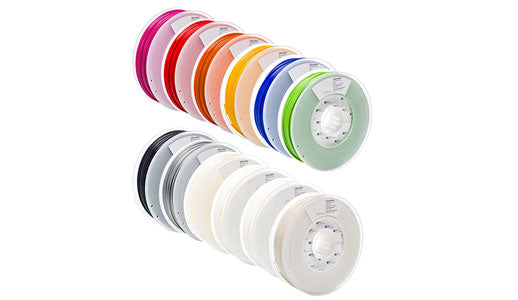Overview
3D Potterbot 10 XL Auger System
The 10 XL ceramic 3D printer can print vessels up to 28" (71cm) high. The 10 XL has the largest extruder out of all of our printers, holding 18 pounds of clay. This lets you print more and reload less. With a 4000ml extruder, you can print dozens of objects and still have clay left over.
3D Potter Clay Printers
3D Potter clay printers use high-quality anodized aluminum rails. These rails are robust and have a smooth surface, allowing for easy movement of parts while being able to withstand classroom or industrial environments.
The unique feature of our printers is the direct extrusion of real clay. Other brands use a compressed air system printing with slip (watered down clay or an alcohol diluted clay). The advantage of direct extrusion is the ability to print with full bodied clay, or other paste-like materials. All materials used to build our printers are food grade, so get creative.
The 10th generation ceramic 3D printer brings a full web interface controlled over WiFi. You can now control and upload files to the printer from multiple devices simultaneously. The interface allows you full control over every setting of the machine. Interface preview.
The 10th generation also has a uniform nozzle design across all of our printers. This allows you to interchange nozzles between all of our printers, from the Micro to the Scara V3.
3D Potterbot Ceramic Printer Comparison Chart
Package Contents
3D PotterBot 10 XL with Auger System
Package Contents
What's included:
• 3D PotterBot 10 XL with Auger System
• Closed loop stepper on X, Y, Z, extruder
• Optional 3600ml or 4000ml extruder, 2 tubes and anti-Rotator, Anodized aluminum print nozzles (in sizes: 3, 4, 5, and 6mm)
• 2 nozzles, 1/2 in and 3/4 in. 1 in opening with no nozzle
• XL Parts Box
• Power Supply
• Wall mount bracket
Specifications
Specifications
Printing Envelope:
• X-19.3" (490 mm)
• Y-19.3" (490 mm)
• Z-28" (710 mm)
*Note, Auger Z height print envelope is approximately 24"
Printer size:
• W-32” L-40” H-47”
• Normal operation space needed 3600ml: W-32” L-40” H-82”
• Normal operation space needed 4000ml: W-32” L-40” H-85”
• Maximum operation space needed: W-35” L-42” H-89”
• Print Bed 15x15in” (381x381mm)
• Height with the extruder fully extended is 89” (2260mm)
• Weight with extruder: 60 lbs.
• Recommended print speed: 1.1”/s’ to 7.9’’/s (30 to 200 mm/s)
• Maximum print speed: 7.9in”/s (200mm/s)
• Power Supply: Output - 24V 10 amps, Input - 100-240V, 50-60 Hertz.
• Power consumption: 24V ~6 amps, ~144 Watts
• Main controller board running Duet3D with Atmel SAM4E8E: 120MHz ARM Cortex-M4
• Full control through the web interface, no apps or software installation.
Helpful Resources
The Pugmill
The easiest way to load extruder tubes is with a pugill. For best results, a de-airing pug mill and a double auger will give you better performance than a single auger.
Although a single auger is adequate, the consistency of the clay is more critical when it comes to loading the tubes. The consistency of the clay should be similar to standard throwing clay, but wetter. This can be accomplished by running the clay through the pug mill and adding a small quantity of water. If too much water is added to the clay the pug mill can actually not function sufficiently enough to load the tubes. This happens because the auger has no traction against the side of the pug mill as the clay mixture becomes too loose. It also depends on the pug mill and its ability to forcefully push the clay. It is necessary to have an adaptor for the nozzle of the pug mill to attach the polycarbonate tube for loading.
Recommended De-airing Pugmills
The Peter Pugger VPM-9 and VPM-20 series, which are ready-to-use with the 3D Potter machines with their existing pugmill adapter are a great option for your needs.
Loading By Hand
Using a 25 lb. bag of prepared clay, cut the clay into 4 pieces and put a microfiber towel in between the 4 pieces. Add 15 ounces of water to the bag, close the bag and make it airtight. Wait until the water has penetrated the clay, approximately one to two days. Now using the moist clay roll it into a cylinder a little bit smaller than the inside of the tube you are loading.
Put the nozzle on the tube with tape over the end and gently tap the clay into the tube. Make sure to tap the tube and nozzle on a soft surface. This is the best method to load your tubes without a pug mill.
Wall Mount Clay Extruder
We now offer an easy way of handloading tubes without the added expense of purchasing a large pug mill. Although a de-airing pug mill is by far the best way to load the tubes, this wall-mounted loader is a very good second choice.













